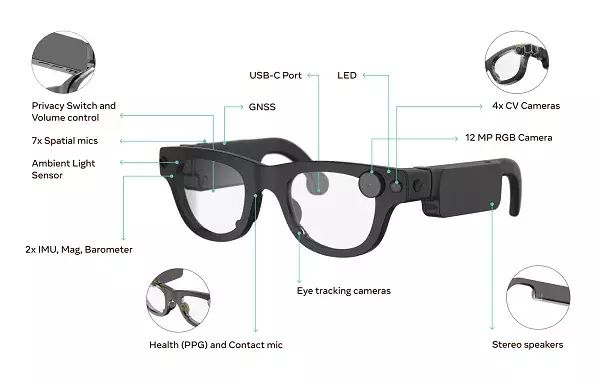In a world where technology is relentlessly advancing, Meta is placing significant bets on augmented reality (AR) as a transformative medium that could redefine how we engage with the digital landscape. The tech giant has recently peeled back the layers on its second-generation AR glasses, dubbed “Aria Gen 2.” These glasses are more than just a technological gadget; they symbolize Meta’s ambition to shape tomorrow’s interaction paradigms and enshrine AR as a mainstream application for everyday tasks. As staggering as it might seem, CEO Mark Zuckerberg has even classified these glasses as the “holy grail” of mobile devices, aiming to supplant smartphones in the long run.
Meta’s latest presentation sheds light on the integration of advanced technologies designed to promote both functionality and aesthetic appeal. The Aria Gen 2 glasses are poised to offer an elevated AR experience due to the unique blending of cutting-edge features with a fashionable design ethos. While many tech companies often falter when merging utility and style, Meta appears to be steering clear of those pitfalls.
Design: Marrying Style with Functionality
One of the standout features of Aria Gen 2 is its thoughtful consideration of wearability. Weighing in at a mere 74 to 76 grams, the glasses are designed for long-lasting comfort without compromising on functionality. The introduction of folding arms adds a layer of practicality to the design, making it simplistic to carry and store. Unlike clunky iterations that make one resemble a sci-fi character, the sleek design is intended to be a fashion-forward accessory rather than merely a piece of technology. This aligns perfectly with today’s consumers, who seek products that complement their personal style while being technologically advanced.
Moreover, Meta has taken into consideration the diversity in human facial structures by offering the glasses in eight different sizes. This customization ensures that fit is not just a cosmetic concern but a fundamental one, enhancing the overall user experience. The thoughtful engineering that accommodates various face morphologies points toward a commitment to inclusivity, an often overlooked element in tech design.
Technological Advances: Bridging Reality and Virtuality
Meta has vigorously invested in augmenting the technical prowess of the Aria Gen 2 glasses, emphasizing their potential for impactful interactive experience. Enhanced camera sensors allow for flexible performance across varying light conditions, while a broadened field of view offers users an immersive encounter with the digital elements superimposed in their real-world environment. The device doesn’t stop there; it incorporates a contact microphone that resides in the nosepad, amplifying sound capture even in bustling surroundings. This demonstrates Meta’s obsession with user-centric design, which not only prioritizes aesthetics but also considers functional efficacy in chaotic environments.
Eye and hand-tracking technologies signify another leap forward, creating an interface that transcends traditional controls. This presents an intriguing possibility—interactions through gestures that only the user can see. However, this may introduce an unusual spectacle to public spaces; individuals miming actions in the air to communicate with their devices. It might seem eccentric at first, but societies adapt quickly to new norms. In the grand scheme of connectivity, these changes signal a paradigm shift that could take familiar interactions into the realm of the extraordinary.
The Road Ahead: Towards Consumer Launch
The timeline for the widespread adoption of Meta’s AR glasses is strategically outlined, pointed towards a consumer launch in 2027. Before that, Meta plans to open up its platform for external developers, nurturing an ecosystem that could offer innovative applications and uses for the Aria Gen 2. This preemptive collaboration with developers is crucial for creating a diverse range of experiences beyond Meta’s direct offerings, ensuring the glasses evolve into a robust platform for AR interactions.
As Meta steadily prepares for its entrance into the retail market, the anticipation builds. The road to transforming how we interact with not only technology but the world around us is fraught with challenges and expectations. However, the push towards an interconnected existence through AR may just mark the next zenith of digital evolution, elevating the mundane to the extraordinary.

